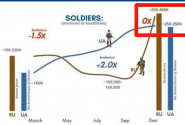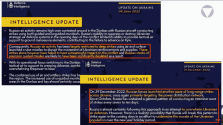You are using an out of date browser. It may not display this or other websites correctly.
You should upgrade or use an alternative browser.
You should upgrade or use an alternative browser.
The War in the Ukraine
- Thread starter SampanViking
- Start date
The Ukrainian government bizarrely still claims that Russia is not in possession of Soledar.Congratulations on officially taking Soledar, Russia.
Hoped to post this earlier, but wanted to wait for concrete confirmation. Here's to better and greater things in 2023 for Russia.
I am sure there are many disciples of Baghdad Bob amongst the Ukrainian administration.
Last edited:
An episode of the use by Russian military personnel in Ukraine of a gun against drones. Anti-drone weapons are reinforced with additional antennas with increased beam gain. After intercepting the drone of the Ukrainian army, the calculation immediately leaves so as not to fall under the blow of Ukrainian artillery.
152-mm self-propelled howitzer 2S3 "Acacia" of the Ukrainian army, came under attack from the Russian kamikaze drone "Lancet". The drone attack took place near Konstantinovka in the Ugledar direction. SAU 2S3 "Acacia" was damaged and was abandoned by the crew.
The calculation of the Russian 152-mm self-propelled guns "Msta-S" spoke about the tactics of using an artillery mount in Ukraine. The firing range of the Msta-S self-propelled guns with a conventional projectile is 25 km.
152-mm self-propelled howitzer 2S3 "Acacia" of the Ukrainian army, came under attack from the Russian kamikaze drone "Lancet". The drone attack took place near Konstantinovka in the Ugledar direction. SAU 2S3 "Acacia" was damaged and was abandoned by the crew.
The calculation of the Russian 152-mm self-propelled guns "Msta-S" spoke about the tactics of using an artillery mount in Ukraine. The firing range of the Msta-S self-propelled guns with a conventional projectile is 25 km.
Russians have done some probing attack around the Seversk salient, it may be that the next offensive will be here.
A minute of silence for my favorite propaganda minister since Muhammad Saeed al-Sahhaf. Such is the price of letting the truth slip out once.
Don't worry about being sent to the Russian Front, the Russian Front is coming here.
Don't worry about being sent to the Russian Front, the Russian Front is coming here.
It still a question what are those forces build up in Belarus and apparently Belgorod doing. I'm still thinking taking Sumy and Kharkov are still on the table but who knows.
and saw a vid on twitter of Russians keeping T-90's in a warehouse in Rubizhne.. It got geolocated. If they smart enough, those tanks wont be there anymore as soon as the video got out.
ouch... well i think he has done well tho. Mainly on Western spectators and to some extent Russian speakers.
and saw a vid on twitter of Russians keeping T-90's in a warehouse in Rubizhne.. It got geolocated. If they smart enough, those tanks wont be there anymore as soon as the video got out.
A minute of silence for my favorite propaganda minister since Muhammad Saeed al-Sahhaf. Such is the price of letting the truth slip out once.
Don't worry about being sent to the Russian Front, the Russian Front is coming here.
ouch... well i think he has done well tho. Mainly on Western spectators and to some extent Russian speakers.
I thought that this was a quite interesting video. Not a military expert, but here are my takeaways.A nice annual review of the War in Ukraine was just published by the Austrian Army.
1. A major Russian weakness was lack of men.
In 1:48, the officer analyses the Russian BTG (battle tactical group) and states, "The biggest problem was the lack of infantry."
This accords with what a blogger named Anatoly Karlin said, in which he argued that the initial plan's greatest flaw was lack of troops. He claimed that only 30K troops attacked Kiev, comparing this to 1.5 German divisions attacking a major Soviet city in WWII.
The video offers this graph.

I don't know whether or not this graph is accurate.
Still, I think it's clear that during the spring and summer of 2022 - Russian troop levels were stagnant or decreasing. However, Ukrainian troop levels consistently increased due to mobilisation. This resulted in the successful Kharkov offensive.
It's also interesting that the first Russian success since the summer (in Soledar) came shortly after Russia regained its manpower advantage.
Russian will probably need another mobilisation this spring?
2. At one point, Russia successfully countered HIMARS.
According to the officer, Russia initially defeated HIMARS through its PANTSIR system.
He then claims that after America provided the AGM-88 HARM missile, HIMARS succeeded.
I believe the first claim; a NATO officer admitting failure of an American system comes off as credible. This goes against the convention that HIMARS instantly changed the war.
3. Ukraine used "hydrotechnical warfare" (dam-blowing) effectively.
Ukraine successfully slowed and stopped Russian advances by flooding towns (such as Irpin) after blowing up dams.
Taiwan which I guess could be used the same way. I think the PLA should blow these up in the initial bombing campaign before any land assault (and then wait for the water to dry). Flooding Taiwanese cities before any landing would also damage Taiwanese army preparations. Based on my observations of the PLA, I'm a bit skeptical that this would actually happen (meaning that the Taiwanese would blow up their dams in the middle of any land battle, substantially delaying any Chinese advance).
4. He subtly made fun of British
I enjoyed this part of the video.

Russian deep strikes "failed to have a meaningful impact on the conflict" all the way until they destroyed Ukraine's electricity grid.
There was same information about the priorisitng algorythm of Russian air defences.2. At one point, Russia successfully countered HIMARS.
According to the officer, Russia initially defeated HIMARS through its PANTSIR system.
He then claims that after America provided the AGM-88 HARM missile, HIMARS succeeded.
I believe the first claim; a NATO officer admitting failure of an American system comes off as credible. This goes against the convention that HIMARS instantly changed the war.
The Pantsirs can identify and prioritise the HARM missiles, means they could used only to temporary distract the defence systems.
Means they could be usefull only if launched with the HIMARS. The HIMARS will have better chances to hit anything if the Pantsirs busy to destroy the HARM missiles.
However it simply means the pintpoint accuracy + high cost require more missiles too, just te keep busy the air defence systems. So say twelve HIMAR lanuched missile require how many HARM to have chance to hit anything ? two, six ?
I thought that this was a quite interesting video. Not a military expert, but here are my takeaways.
1. A major Russian weakness was lack of men.
In 1:48, the officer analyses the Russian BTG (battle tactical group) and states, "The biggest problem was the lack of infantry."
This accords with what a blogger named Anatoly Karlin said, in which he argued that the initial plan's greatest flaw was lack of troops. He claimed that only 30K troops attacked Kiev, comparing this to 1.5 German divisions attacking a major Soviet city in WWII.
The video offers this graph.
View attachment 105266
I don't know whether or not this graph is accurate.
Still, I think it's clear that during the spring and summer of 2022 - Russian troop levels were stagnant or decreasing. However, Ukrainian troop levels consistently increased due to mobilisation. This resulted in the successful Kharkov offensive.
It's also interesting that the first Russian success since the summer (in Soledar) came shortly after Russia regained its manpower advantage.
Russian will probably need another mobilisation this spring?
2. At one point, Russia successfully countered HIMARS.
According to the officer, Russia initially defeated HIMARS through its PANTSIR system.
He then claims that after America provided the AGM-88 HARM missile, HIMARS succeeded.
I believe the first claim; a NATO officer admitting failure of an American system comes off as credible. This goes against the convention that HIMARS instantly changed the war.
3. Ukraine used "hydrotechnical warfare" (dam-blowing) effectively.
Ukraine successfully slowed and stopped Russian advances by flooding towns (such as Irpin) after blowing up dams.
Taiwan which I guess could be used the same way. I think the PLA should blow these up in the initial bombing campaign before any land assault (and then wait for the water to dry). Flooding Taiwanese cities before any landing would also damage Taiwanese army preparations. Based on my observations of the PLA, I'm a bit skeptical that this would actually happen (meaning that the Taiwanese would blow up their dams in the middle of any land battle, substantially delaying any Chinese advance).
4. He subtly made fun of Britishintelligence updatespropaganda.
I enjoyed this part of the video.
View attachment 105268
Russian deep strikes "failed to have a meaningful impact on the conflict" all the way until they destroyed Ukraine's electricity grid.
Russians themselves report many AGM-88 missiles being intercepted by SAMs, and I have yet to encounter proof that the AGM-88 has taken down a single SAM or radar unit during this war. Drone footage please even the Russians need to exercise drone hit confirmation as they do with the Lancets. On top of all this, MiG-29 with AGM-88 are constantly getting shot down by different means including air to air by Su-35 and MiG-31.
Ukrainians found a way to get HIMARS through Russian AD defenses by firing HIMARS with Grad MLRS for saturation attacks, with the Russian AD taking out the Grad rockets and letting the HIMARS through. This was rectified by a software update on the AD systems that help identify HIMARS tracks from Grads.
Thirdly, not just Pantsyrs but Buk M2, Buk M3 and S300V systems are involved with the interception of HIMARS and all other MLRS rockets. This does not mean however that all the gaps are plugged, given the RCS of any MLRS rocket, only short to midrange interception is possible which still means many areas remain uncovered.
For something unrelated so I don't have to post it separately, a Ukrainian Kazak 2M1 lies burning after hit by artillery.
